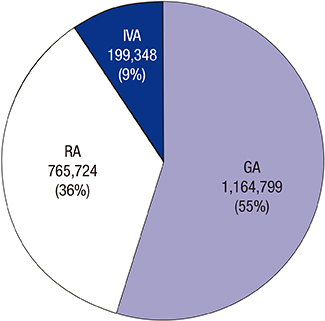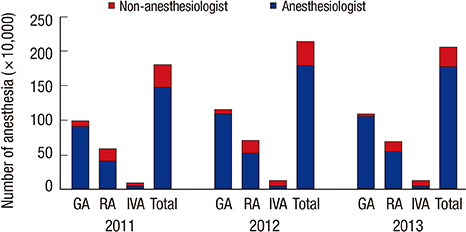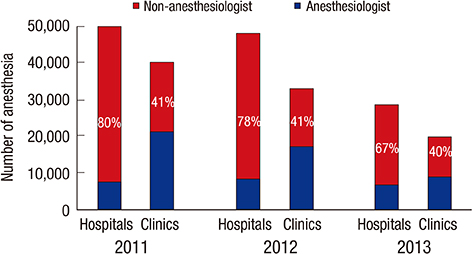J Korean Med Sci.
2016 Jan;31(1):131-138. 10.3346/jkms.2016.31.1.131.
The State of Anesthetic Services in Korea: A National Survey of the Status of Anesthesia Provider in the 2011-2013 Period
- Affiliations
-
- 1Department of Anesthesiology and Pain Medicine, College of Medicine, The Catholic University of Korea, Seoul, Korea. hongs@catholic.ac.kr
- 2Department of Health Business Administration, Woosong University, Daejeon, Korea.
- 3Graduate School of Public Health, Institute of Health Services Research, Yonsei University, Seoul, Korea.
- 4Deparment of Anesthesiology and Pain Medicine, Anesthesia and Pain Research Institute, Yonsei University College of Medicine, Seoul, Korea.
- 5Department of Anesthesiology and Pain Medicine, Sanggye Paik Hospital, Inje University, Seoul, Korea.
- 6Department of Anesthesiology and Pain Medicine, Seoul National University College of Medicine, Seoul, Korea.
- KMID: 2360003
- DOI: http://doi.org/10.3346/jkms.2016.31.1.131
Abstract
- Active involvement of anesthesiologists in perioperative management is important to ensure the patients' safety. This study aimed to investigate the state of anesthetic services in Korea by identifying anesthetic service providers. From the insurance claims data of National Health Insurance for 3 yr, the Korean state of anesthetic services was analyzed. The claims for anesthesia from the medical institutions which hire their own anesthesiologist or with an anesthesiologist invitation fee are assumed to be the anesthesia performed by anesthesiologists. The annual anesthetic data were similar during the study period. In 2013, total counts of 2,129,871 were composed with general anesthesia (55%), regional anesthesia (36%) and procedural sedation with intravenous anesthetics (9%). About 80% of total cases of general anesthesia were performed in general hospitals, while more than 60% of the regional anesthesia and sedation were performed in the clinics and hospitals under 100 beds. Non-anesthesiologists performed 273,006 cases of anesthesia (13% of total) including 36,008 of general anesthesia, 143,134 of regional anesthesia, and 93,864 of sedation, mainly in the clinics and hospitals under 100 beds. All procedural sedations in the institutions without direct employed anesthesiologist were performed by non-anesthesiologists. Significant numbers of anesthesia are performed by non-anesthesiologist in Korea. To promote anesthetic services that prioritize the safety of patients, the standard to qualify anesthetic service is required. Surgeons and patients need to enhance their perception of anesthesia, and the payment system should be revised in a way that advocates anesthesiologist-performed anesthetic services.
Keyword
MeSH Terms
Figure
Reference
-
1. Wong A. From the front lines: a qualitative study of anesthesiologists' work and professional values. Can J Anaesth. 2011; 58:108–117.2. Agarwala AV, McCarty LK, Pian-Smith MC. Anesthesia quality and safety: advancing on a legacy of leadership. Anesthesiology. 2014; 120:253–256.3. Roh WS, Kim DK, Jeon YH, Kim SH, Lee SC, Ko YK, Lee YC, Lee GH. Analysis of anesthesia-related medical disputes in the 2009-2014 period using the Korean Society of Anesthesiologists database. J Korean Med Sci. 2015; 30:207–213.4. Hove LD, Steinmetz J, Christoffersen JK, Møller A, Nielsen J, Schmidt H. Analysis of deaths related to anesthesia in the period 1996-2004 from closed claims registered by the Danish Patient Insurance Association. Anesthesiology. 2007; 106:675–680.5. Wacker J, Staender S. The role of the anesthesiologist in perioperative patient safety. Curr Opin Anaesthesiol. 2014; 27:649–656.6. Hong SJ, Kang YJ, Jeon YH, Son JS, Song JH, Yoo CS, Kim DK. Analysis of expert consultation referrals to the Korean Society of Anesthesiologists (KSA): a comparison of procedural sedation and general anesthesia. J Anesth. 2013; 27:218–223.7. Jones RS. Health-Care Reform in Korea. Economics Department Working Papers No. 797. OECD Publishing;accessed on 8 April 2015. Available at: http://dx.doi.org/ 10.1787/5kmbhk53x7nt-en.8. Pearse RM, Dana EC, Lanigan CJ, Pook JA. Organisational failures in urgent and emergency surgery. A potential peri-operative risk factor. Anaesthesia. 2001; 56:684–689.9. Silber JH, Kennedy SK, Even-Shoshan O, Chen W, Mosher RE, Showan AM, Longnecker DE. Anesthesiologist board certification and patient outcomes. Anesthesiology. 2002; 96:1044–1052.10. Sury MR, Palmer JH, Cook TM, Pandit JJ. The state of UK anaesthesia: a survey of National Health Service activity in 2013. Br J Anaesth. 2014; 113:575–584.11. Enright A. Review article: safety aspects of anesthesia in under-resourced locations. Can J Anaesth. 2013; 60:152–158.12. Glenshaw M, Madzimbamuto FD. Anaesthesia associated mortality in a district hospital in Zimbabwe: 1994 to 2001. Cent Afr J Med. 2005; 51:39–44.13. Hansen D, Gausi SC, Merikebu M. Anaesthesia in Malawi: complications and deaths. Trop Doct. 2000; 30:146–149.14. Ouro-Bang'na Maman AF, Tomta K, Ahouangbévi S, Chobli M. Deaths associated with anaesthesia in Togo, West Africa. Trop Doct. 2005; 35:220–222.15. Lee JJ, Lee NH, Park CM, Hong SJ, Kong MH, Lee KH, Yon JH, Song SO. Public awareness about the specialty of anesthesiology and the role of anesthesiologists: a national survey. Korean J Anesthesiol. 2014; 66:12–17.16. American Society of Anesthesiology. Distinguishing monitored anesthesia care ("MAC") from moderate sedation/analgesia (conscious sedation). accessed on 7 April 2015. Available at: http://www.asahq.org/For-Members/Standards-Guidelines-and-Statements.aspx.17. Campbell G, Arfanis K, Smith AF. Distraction and interruption in anaesthetic practice. Br J Anaesth. 2012; 109:707–715.18. Haller G, Stoelwinder J, Myles PS, McNeil J. Quality and safety indicators in anesthesia: a systematic review. Anesthesiology. 2009; 110:1158–1175.19. Lee KH, An TH, Choi JH, Lim DG, Lee YJ, Kim DK. Analysis of expert consultation referrals for anesthesia-related issues (December 2008-July 2010): KSA legislation committee report. Korean J Anesthesiol. 2011; 60:260–265.20. Merry AF, Cooper JB, Soyannwo O, Wilson IH, Eichhorn JH. International standards for a safe practice of anesthesia 2010. Can J Anaesth. 2010; 57:1027–1034.
- Full Text Links
- Actions
-
Cited
- CITED
-
- Close
- Share
- Similar articles
-
- The state of anesthesia in South Korea: a national survey of the status of anesthetic service activity in 2014–2016
- A Case of Status Asthmaticus during Spinal Anesthesia for Cerarian Section of Chronic Asthma Patient
- A survey of user acceptance of electronic patient anesthesia records
- Cerebral hemorrhage presenting as alteration of consciousness during the anesthesia recovery period: A case report
- Evaluation of changes in anesthetic methods for cesarean delivery: an analysis for 5 years using the big data of the Korean Health Insurance Review and Assessment Service




